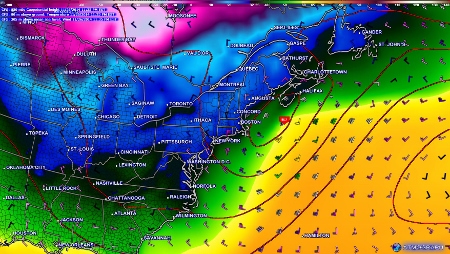Rain, Then Snow on the Summit
2014-11-24 16:53:46.000 – Michael Dorfman, Weather Observer/IT Specialist
While rain pushes through the area today (see above), we’re all on the edge of our seats monitoring the forecast for Wednesday night and Thursday for what could be the first significant snowfall for the area! While the different weather models have not come into complete agreement, it looks like a coastal storm will be pushing into the region Wednesday and Thursday. At this point, it seems to be hugging the coast, with less of an effect further inland, but models can change dramatically in 48 hours, so keep your eyes peeled for updates!
Why is this storm rain and not snow? The simple answer is because it is too warm. But what dictates temperature in storms? One big principle in meteorology is that the characteristics of an air mass depend on where that air mass comes from. Low-pressure systems consist of a large area of atmosphere rotating counter-clockwise. In a perfect world, if you’re to the west (left) of the storm, the air mass you encounter will be coming from the north, and will generally be colder than typical air from your latitude. This is known as the “cold sector” of a storm. On the other hand, if the center of the storm is to your west, an air mass from the south is pushing toward you, allowing you to feel warmer temperatures, and increasing the chance of rain during winter storms. Of course, the atmosphere is never perfect, so variables involving atmospheric conditions, geography and water temperatures all play a role in how this general concept applies to specific situations.
We are currently being pummeled by rain from a low-pressure system. With southerly winds, our air mass is very warm, hence why we aren’t receiving snow from this storm (even on the summit of Mount Washington!) To the frustration of ski-minded individuals, the air mass that is pushing into the area gained a large amount of ocean moisture, allowing it to drop a significant amount of rain on the summit.


Michael Dorfman, Weather Observer/IT Specialist
A Look at The Big Wind and Measuring Extreme Winds At Mount Washington
A Look at The Big Wind and Measuring Extreme Winds at Mount Washington By Alexis George Ninety-one years ago on April 12th, Mount Washington Observatory recorded a world-record wind speed of 231 mph. While
MWOBS Weather Forecasts Expand Beyond the Higher Summits
MWOBS Weather Forecasts Expand Beyond the Higher Summits By Alex Branton One of the most utilized products provided by Mount Washington Observatory is the Higher Summits Forecast. This 48-hour forecast is written by MWOBS
One Down, One To Go
One Down, One to Go By Ryan Knapp On my calendar for March 2025, I had two reminders of events to look forward to in the sky. The first occurred this past week with




